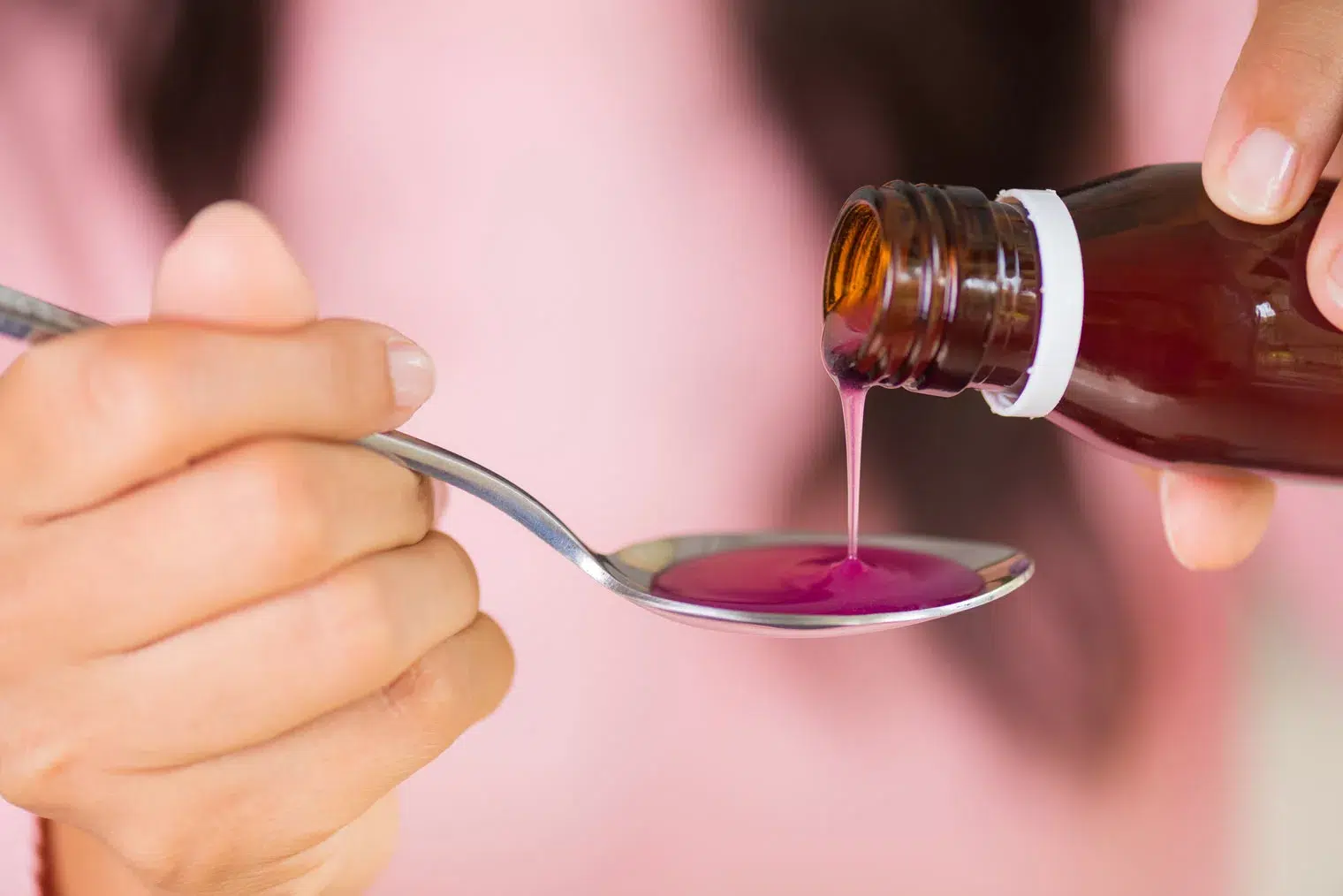Addiction to Promethazine-Codeine Cough Syrup
Table of Contents
Lean is a common slang term for a drink that contains prescription-strength cough syrup as its active ingredient. The cough syrup used for this purpose contains the allergy medication promethazine. It also contains the opioid pain reliever/cough suppressant codeine. Lean is classified as an illicit recreational substance. Consumption of it can lead to a range of serious problems. These potential problems include the development of an opioid addiction.
What Is Lean
Lean is always a mixture of ingredients. As a rule, a batch of this drink contains some sort of soda in addition to promethazine-codeine syrup. In some cases, hard candies are added to the mixture as flavor enhancers.
Promethazine helps treat allergies by acting as an antihistamine. The medication also has a sedating effect. Codeine is an opioid primarily used as a treatment for mild-to-moderate forms of pain. When mixed with a medication like promethazine, it can also help limit coughing.
Free Mental Health Assessment
Why is cough syrup containing these two substances targeted for recreational use? Like all opioids, codeine has the ability to produce the extreme, pleasurable state known as euphoria. It can also produce general feelings of relaxation. The sedative effects of promethazine add further enticement for misuse and abuse.
You may also hear the same mixture of cough syrup and soda referred to by other names. Alternative slang terms for Lean include Sizzurp and Syrup. They also include the term Purple Drank. This last name is derived from Lean’s characteristic deep purple color.
The Rise of Sizzurp in Pop Culture
The use of Lean/Sizzurp first entered pop culture in the late 1990s and early 2000s. Its place of entry was the local hip hop community in Houston, TX. From there, it spread to wider hip hop culture. As more and more rappers mentioned Lean in their songs, awareness of its use and effects entered the mainstream.
Today, changes in federal law have helped restrict access to promethazine-codeine syrup. As a result, the popularity of Lean has fallen. However, the syrup can still be obtained illegally. In addition, some people use a nonprescription cough medicine called dextromethorphan as a promethazine-codeine substitute.
The Effects of Codeine Intoxication
As an opioid, codeine is a central nervous system depressant. This means that it makes your brain and spinal cord work at a slower pace than usual. The medication also helps stop your brain from receiving pain signals from your body.
A crucial factor in the targeting of codeine for abuse is the euphoria that comes with its use. Some people find this euphoric feeling to be irresistible. As a result, they start using codeine, or a codeine-based substance like Lean, over and over again. It is this repeated use that helps set the process of eventual addiction in motion.
Is Lean Addictive
Is Lean addictive to its users? Since the mixture contains codeine, the answer to this question is yes. How can Lean use trigger addiction? Addiction has three core aspects or elements. As a rule, the first issue to arise is physical dependence. Your are physically dependent on a substance when your brain starts to expect its presence in your system.
Once you are physically dependent, continued use of Lean can lead to psychological dependence. With this form of dependence comes a strong emotional need for more codeine. This need manifests as what specialists call drug-seeking behavior. It is this behavior that marks the clear arrival of addiction.
Not everyone who uses Lean will become addicted. But even in the absence of addiction, abuse of codeine can seriously harm your health. For this reason, experts consider both addiction and damaging, non-addicted abuse as reasons to seek treatment.
Does Lean Cause Withdrawals
Do people who stop using Lean experience symptoms of withdrawal? The answer to this question varies with the presence or absence of addiction. People who are not dependent on Lean’s codeine content will not experience withdrawal. However, people affected by codeine addiction can expect to go through withdrawal if they:
- Stop using Lean
- Make sharp cuts in the amount of Lean they typically consume
How can you tell if you are experiencing codeine withdrawal? All opioids produce a similar withdrawal syndrome. Possible symptoms of this syndrome include:
- Anxiousness and/or mental agitation
- Achy muscles
- Excessive yawning, sweating or production of mucus or tears
- Cramps in your abdomen
- Dilated, or narrowed, pupils
- Nausea with or without vomiting
- Sleeplessness or other sleep difficulties
- Loose bowels
- Gooseflesh, also known as goose bumps
The Side Effects of Regular Lean Use
Even in the absence of addiction, regular use of Lean can lead to serious side effects. These effects may come from the drink’s codeine content and/or its promethazine content. Major, codeine-related side effects of regular Lean use may include:
- Hallucinations
- An agitated mental state
- Heartbeat abnormalities
- Lack of appetite
- Unexplained dizziness or weakness
- Skin changes such as itching, hives or a rash
- Convulsions, i.e., seizures
- Shallow or labored breathing
- Problems swallowing normally
All of these problems are signs that you need medical attention as soon as possible.
More than two dozen major side effects can occur in people who use promethazine. The list of these effects includes:
- An elevated body temperature
- Muscle stiffness
- Breathing difficulties
- A confused or unalert mental state
- Dizziness
- Convulsions
- A rash or hives
- Unexplained bleeding or bruising
- A rapid or irregular heartbeat
- Jaundice
As with codeine, problems like these require prompt medical treatment.
Can You Overdose on Lean
You can overdose on any substance or mixture that contains an opioid. Such overdoses happen when an opioid’s drug effects disrupt key organs and systems in your body. Codeine overdoses produce telltale signs and symptoms that can include:
- Muscle tremors or twitches
- Skin that feels cold and clammy to the touch
- Unusual drowsiness
- Abdominal spasms
- Mental confusion
- Blue coloration in your lips or under your fingernails
- Constipated bowels
- Dizziness or lightheadedness
- An inability to stay awake
- A coma, i.e., unresponsive unconsciousness
All opioid overdoses are dire emergencies. You can die without immediate medical assistance.
24 Hour Mental Health Hotline
Methods of Treatment for Lean Addiction
There are two main methods of treatment for Lean addiction. First, you need medication to help you successfully complete codeine withdrawal. In addition, you may need further medication to help you stay sober after codeine is out of your system.
You also need the recovery support provided by psychotherapy. Modern therapy for opioid addiction is behavioral. This means that it focuses on helping you change how your everyday behavior regarding opioids like codeine. The combination of medication and therapy for opioid problems is commonly known as medication-assisted treatment, or MAT.
Recovery From Lean Addiction Is Possible at Emerald Isle
Lean, also known as Sizzurp or Purple Drank, is a mixture of soda and promethazine-codeine cough syrup. It may also contain other, flavor-enhancing additives. The codeine content in Lean makes it addictive. Consumption of the beverage can also lead to serious side effects requiring medical attention. In addition, you can overdose on Lean and potentially die as a result.
If you are affected by Lean addiction, recovery is a realistic, achievable goal. At Emerald Isle, we provide customized opioid treatment that helps you reach this crucial goal. We can also help you recover from any other form of opioid addiction. Call us today for more information on our personalized treatment programs. You can also contact us through our online form.


